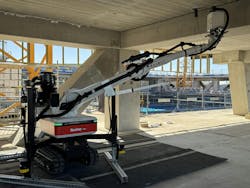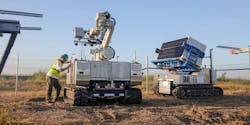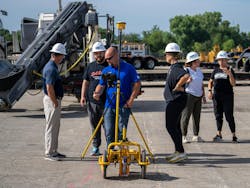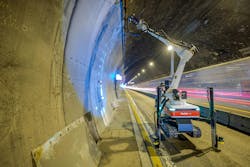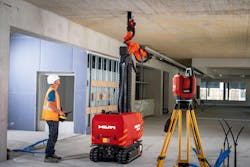Key Takeaways
- Cobots are designed to work safely alongside humans, expanding their use beyond factories into construction, solar farms, and utility maintenance.
- Surveying and marking tasks are accelerated and made more accurate with robots, reducing labor shortages and human error.
- Robotic systems are improving ergonomic conditions, helping retain employees by minimizing repetitive strain injuries and physical fatigue.
For decades, robots labored almost exclusively in factories, where cages, fences, and other physical barriers kept people at a safe distance to avoid injury. In the mid-1990s, the concept expanded to “cobots,” which are designed to work safely alongside people. Hence their name, which is short for “collaborative robots.”
Today, cobots are increasingly found outside factories, too, including construction sites. One recent example is the cobot Rosendin Electric developed for installing panels at solar farms (see Photo 1). Their levels of autonomy run the gamut. Some are like apprentices who don’t need continuous, direct supervision, while others are closer to forklifts, not budging without a human at the controls.
By going beyond what most people consider robots, cobots show that there’s a wider range of use cases and business benefits, including ones that are relatively easy and inexpensive to implement with existing workflows. For example, many cobot use cases center around safety, such as the remote cable cutters that Tri-City Electric uses.
“In an industrial facility, we may have multiple cable sets, and the scope of work is to demo just one,” says Travis Keeney, vice president of risk management at the Davenport, Iowa-based firm. “That cable set may be running alongside the others, meaning some are energized. When you’re dealing with long cable runs like that, there’s a lot of potential for human error in misidentifying the intended cable. We’ve had some near misses over the years where the wrong cable was cut — the energized cable. With remote cable cutters, employees can set everything up and stand back from a safe distance. If worst case (they do cut the wrong cable), at least they’re not in harm’s way.”
In other cases, cobots are used to maximize productivity while minimizing downtime. One example is the LineWise Triple Line Lifters that Great Southwestern Construction uses on energized power lines for electric utilities and other clients.
“There’s no interruption, so there’s no loss of revenue to the utility,” says Billy Walsh, Great Southwestern Construction director of training. “It allows us to take all the energized conductors and keep it in a very controlled setting. The linemen do it all with remote control from 100 feet in the air. They can use it in a horizontal or a vertical setting — whatever that setup requires. We can do anything from a distribution voltage up to 500kV in the transmission world. There’s a whole series of robotic arms with capacities anywhere from 300 to 5,000 pounds per phase.”
Another option for overcoming labor shortages
Other trades increasingly use cobots, so it’s worth looking for use cases that could be adapted to electrical. One example is Emery Sapp & Sons (ESS), which specializes in large civil construction projects. Some of its highway projects are 10 miles long, which surveyors traditionally trekked with a rod, tape, GPS, stakes, and paint. Then ESS began using TinySurveyor Terra (Photo 2). Using GPS and CAD files as its guide, this tricycle-size robot rolls along the concrete, painting a mark every 15 feet so crews know exactly where to cut expansion joints. (Its manufacturer, Monsen Engineering, says it can mark up to 600 points per hour.)
“It is a lot faster,” says Tyler Grotewiel, ESS construction technology manager. “This is our first season with it, and everybody’s liking it and seeing its advantages. Traditionally, the surveyor marked every 90 feet. Then a different crew would come behind with a 100-foot tape measure, a guy on each end, and a guy in the middle, painting every 15 feet. So there are three people right there laying out dots [in a] labor shortage.”
TinySurveyor reduces that to one: a surveyor whose role includes ensuring that it doesn’t get stuck. In terms of potential electrical use cases, TinySurveyor could be used for marking underground duct bank locations as well as infrastructure indoors.
“It would mark out where all your walls go,” Grotewiel says. “We don’t do that, but I’ve seen applications of that. Leica has a version of it. I think it would be tremendous. You’re not pulling a tape [while] reading the plans. You’re uploading the file. It’s drawing all the lines for you, and then you’re just double-checking. It’s got to speed up that process, and it should be more accurate — no human error.”
Grotewiel has seen other robots designed for solar farm applications, such as Civ, whose products can mark locations for piles and trenches.
“I believe it can paint different colors,” Grotewiel says. “So, if your piling lengths are going to be different based on the terrain, a red dot means we’re going to put a 10-foot pile here, and a green dot means 20 foot. Then whoever is delivering materials can see, ‘I need to drop 10s over here and 15s over there.’”
Saving backs and shoulders
There’s also an increasing chance that those and other materials will be delivered by a cobot. One example is Rosendin’s cobot system that carts modules out to the farm and then unloads them one by one onto the racking, where electricians wire them up. The company says a two-person crew can install 350 to 400 modules per eight-hour shift, which is three times more than a traditional crew of three to four people doing everything manually.
Rosendin developed the system in partnership with ULC Technologies, which specializes in robots for utility applications such as racking substation breakers and inspecting the insides of live gas mains. That’s noteworthy because Rosendin is an employee-owned company — not exactly the type that springs to mind when robots are often perceived as taking jobs from people.
In Episode 76 of EC&M’s On Air podcast, Editor-in-Chief Ellen Parson discussed robots with David Lincoln, the Rosendin senior vice president who came up with the idea in 2019. One major motivation was freeing employees from the physical strain of wrestling 100-pound modules off trucks and onto racks, a task now handled by a robotic arm with suction cups. It’s an example of how cobots can help minimize injuries — and the lost productivity that comes with — by shouldering more and more of the dirty, dangerous, and monotonous work. Great Southwestern Construction sees the same benefits with its LineLifters.
“If you look at us physically, there’s been a lot of repetitive strain injuries,” Walsh says. “I think it’s really impacting everyone in the industry from an ergonomic perspective.”
According to Walsh, it’s creating a lot more longevity. “In terms of retention, Tyler Mathis, Great Southwestern Construction Manager’s group, had very little turnover, if any,” he says. “And we’re not seeing guys off work with back injuries, shoulder injuries, and neck injuries to the point that it used to be.”
A growing number of cobots are designed to minimize those injuries inside buildings such as high rises. Two examples are Fischer Group’s BauBot (Photo 3) and Hilti’s Jaibot (Photo 4), which use building information modeling (BIM) data to identify each location to drill a hole for hangers and conduit. This frees workers from the monotony and contortion of spending a whole shift lying on their backs or craning their necks up.
“It’s a pretty simple step to add the drill depth, diameter, and a couple of other attributes and export that from the relevant design software (usually AutoCAD or Revit) as a .CSV file,” Aidan Maguire, Hilti business unit manager for measuring and robotics, told EC&M in 2022. “This .CSV file is then loaded into the Jaibot project cloud, [which] is accessed through a standard web browser. In the field, Jaibot is connected to the internet through a mobile data connection and will sync with the project cloud once the operator logs in. This allows live access to the project planning, allows for updates to the design if required, and syncs back the project progress, including the as-built hole locations.”
Droning on
Drones are essentially flying cobots. One use case is inspecting electric utility lines, towers, and other electrical infrastructure that traditionally required trekking out to those locations. Some telecom contractors use drones equipped with artificial intelligence (AI) and machine vision cameras to inspect cellular towers. The AI is trained to recognize, for example, rusty bolts and missing components. That’s a potential use case for electrical: The drone pilot wouldn’t have to be an electrician because the AI knows what to look for. This would free up journeymen because now they would visit only those sites that have been identified as needing repair.
AI-powered inspection is just one example of how drones could be used to avoid the falls, shocks, and other risks that are inherent in traditional methods such as climbing towers.
“When we’re working in an energized setting, it would be to our advantage if there was a drone that had some induction-reading capability,” says Great Southwestern Construction’s Walsh. “That could go to a deenergized project to tell what the induction level is, especially if we’re in a high-induction corridor.”
Drones are also an example of why cobots and robots are here to stay.
“From my perspective, having been in the industry over the decades, technology has really made an impact in terms of efficiency and productivity,” Walsh says. “Every six months, every three months, there’s a new tool, there’s a new way of managing and controlling that energy. It’s making the industry better. It’s making the industry safer. If you do not stay current with the advancements and if you’re not adaptable, then you’re going to be left behind.”
About the Author
Tim Kridel
Freelance Writer
Kridel is an independent analyst and freelance writer with experience in covering technology, telecommunications, and more. He can be reached at [email protected].
